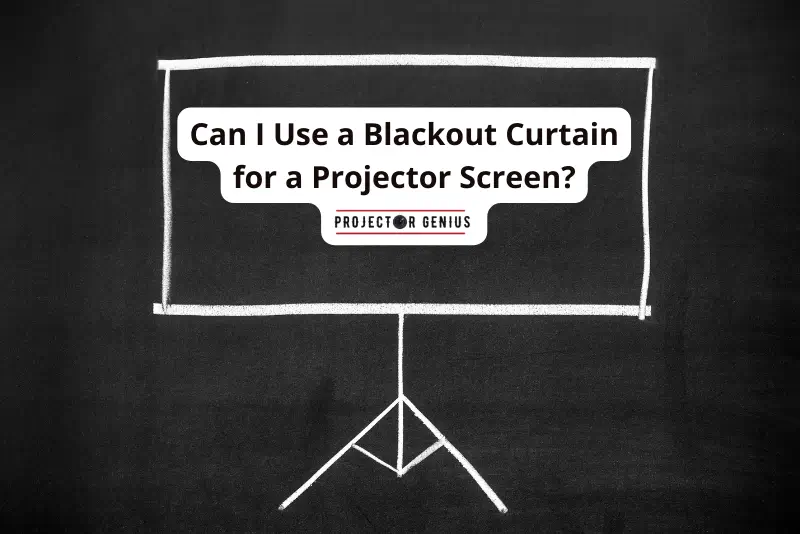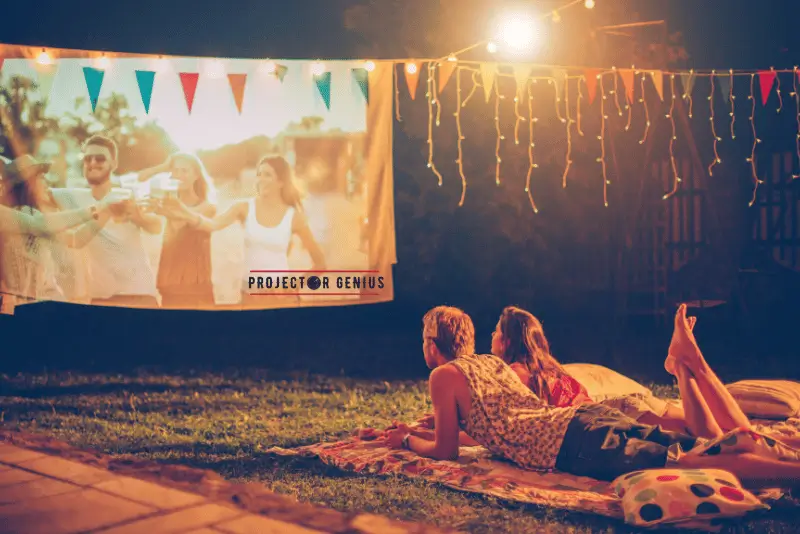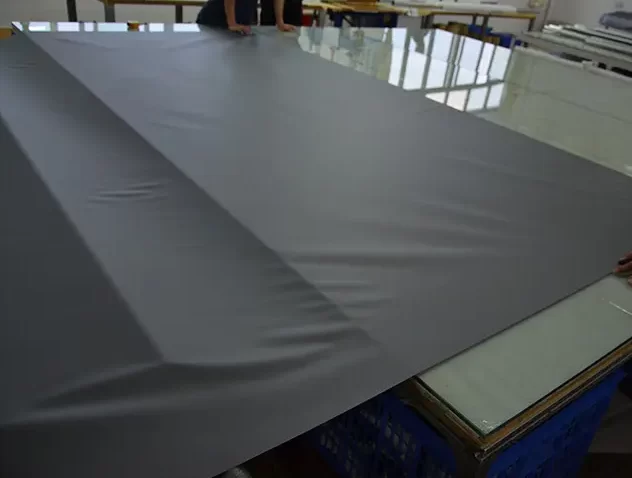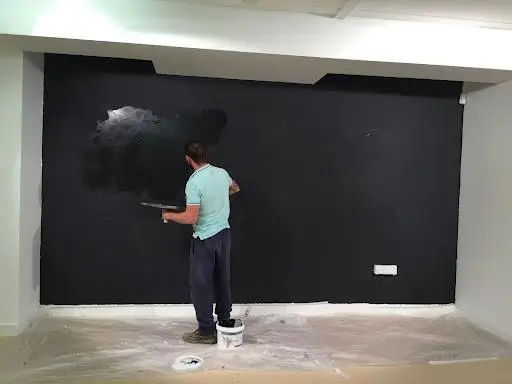Can I Use a Blackout Curtain as Projector Screen? [2023 Complete Guide]
-
 Written by:
Kristy Roger
Written by:
Kristy Roger
- Last Updated:
Have you ever wondered if a simple blackout curtain could double up as a projector screen? It’s a question many home cinema enthusiasts grapple with, especially when on a budget.
Drawing from a consultation at a leading electronics firm and years of hands-on experience, this article delves deep into the feasibility of using blackout curtains as projector screens.
We’ll explore the pros and cons, compare it with dedicated projector screens, and even touch upon other DIY alternatives.
Whether you’re a beginner or a seasoned home cinema aficionado, this guide promises insights that will elevate your viewing experience.
So, let’s dive in and unravel the mysteries of projector screens!

I recommend using the Table of Contents to quickly access the information you need.
My article is designed to cater to home cinema users of all levels, from Beginners to Advanced enthusiasts.
Table of Contents
Can I Use a Blackout Curtain as Projector Screen?
While a blackout curtain won’t replace a high-quality projector screen, it’s a viable option for casual viewing or if you’re on a budget. With the right setup and conditions, you can enjoy a decent movie experience.
And if you ever want to upgrade, there are plenty of screen options out there. But for now, grab some popcorn, dim the lights, and enjoy your movie on your blackout curtain screen!
Factors to Consider Before Using Blackout Curtains as Projector Screen
Surface Smoothness
The smoother the curtain, the better. Any wrinkles or creases can distort the projected image. I remember setting up a leading projector model in my own home cinema and testing it on a blackout curtain. The minor wrinkles were quite noticeable, especially during bright scenes.
Reflectivity
Traditional projector screens are designed to reflect light in a specific way to maximize image quality. Blackout curtains might not have the same level of reflectivity.
Color Accuracy
Blackout curtains might not reproduce colors as accurately as a dedicated projector screen. I recall watching “Finding Nemo” with my kids, Jerry and Ryan, on a makeshift blackout curtain screen. While it was a fun experience, the colors weren’t as vibrant as on a dedicated screen.
Ambient Light
Blackout curtains are great for blocking out external light, which can enhance the viewing experience. This is especially important if you’re setting up in a room with a lot of windows or ambient light.
Quality and Efficiency
Drawing from my Lean Six Sigma credentials, I always emphasize the importance of quality and efficiency. While a blackout curtain can work in a pinch, investing in a dedicated projector screen will provide a consistently better viewing experience in the long run.
In my personal home cinema setup, I initially used a blackout curtain before eventually upgrading to a dedicated screen. The difference in image quality was quite noticeable. However, for those moments when it’s just about gathering with loved ones, like watching movies with Jerry and Ryan, the curtain did the job.
Can I Use Any Other Material from Home for Quick Setup?
Absolutely! Over my 5+ years of consulting on home theater products, I’ve come across various DIY solutions and even experimented with a few in my own home cinema. Here are some alternative materials you can consider:

White Bed Sheet
This is one of the most common DIY solutions. A clean, wrinkle-free white bed sheet can serve as a decent projector screen. I remember setting up a projector for a family movie night in my backyard using a bed sheet. Jerry, Ryan, and I watched “The Lion King,” and while it wasn’t theater-quality, the experience was memorable.
Plywood or MDF Board
If you’re looking for something more rigid, a flat white-painted plywood or MDF board can work. Ensure the surface is smooth and the paint is matte to avoid reflections. During a consultation at a top electronics firm, a client shared their success with this method, especially for outdoor setups.
Wall
A plain, smooth white wall can be an excellent screen. Just ensure it’s free from textures, imperfections, or colors that might distort the image. In my early days of home cinema enthusiasm, before I had a dedicated screen, a wall was my go-to. With the right projector settings, it can give surprisingly good results.
White Poster Board or Foam Board
These can be found at most craft stores and can serve as a makeshift screen for smaller setups or portable projectors. I once tested a mini projector on a foam board, and it worked quite well for a small gathering.
White Canvas
A stretched white canvas, like those used for painting, can also be a good option. The tight, smooth surface can provide a decent image quality.
Educational Insights
From the principles of Electrical Technology, it’s essential to understand that the material’s reflectivity plays a crucial role in image quality. Lighter colors, especially white, tend to reflect projector light better, giving a brighter image. Dark or colored materials can absorb light, leading to a dimmer projection.
Remember, while these DIY solutions can be great for a quick setup or a fun movie night, for regular viewing or if you’re particular about image quality, investing in a dedicated projector screen is advisable. It’s a lesson I learned after testing various materials in my home cinema. Quality and efficiency often lead to better long-term satisfaction.
What is Different Between DIY Screen vs Real Projector Screen?
This is a topic I’ve delved into quite deeply during my years of consulting on home theater products and from my hands-on experiences setting up various projector models in my own home cinema.
Let’s break down the differences between DIY screens and real projector screens, drawing from both my technical background and personal anecdotes:
Material Quality
- DIY Screen: Typically, DIY materials like bed sheets, walls, or plywood aren’t specifically designed for projection. They might not have the optimal reflectivity or texture for a clear image.
- Real Projector Screen: These are crafted with materials that enhance color reproduction, brightness, and contrast. I remember when I first switched from a DIY setup to a dedicated screen, the difference in image clarity was like night and day.
Surface Smoothness
- DIY Screen: Imperfections, wrinkles, or textures can distort the projected image. I recall a movie night with Jerry and Ryan where we used a bed sheet, and the wrinkles slightly distorted the subtitles.
- Real Projector Screen: They are designed to be perfectly flat and smooth, ensuring a uniform and distortion-free image.
Gain
- DIY Screen: Most DIY materials don’t have a specified gain, which refers to the screen’s reflectivity. This can affect the brightness and clarity of the projection.
- Real Projector Screen: They come with a specified gain value, allowing for optimal brightness and contrast. During my time at the University of Alberta, I learned how crucial gain is in determining image quality in projection systems.
Viewing Angle
- DIY Screen: Some DIY materials might not provide a wide viewing angle, leading to faded or distorted images if viewed from the side.
- Real Projector Screen: Many are designed to offer wide viewing angles, ensuring that everyone in the room gets a clear view, regardless of their seating position.
Black Levels and Color Accuracy
- DIY Screen: Colors might not be as vibrant or accurate on DIY screens. Black levels can also appear more grayish.
- Real Projector Screen: Some high-quality screens come with a black backing or special coatings to enhance black levels and color depth. I’ve personally noticed this difference when watching darker films in my home cinema.
Portability and Setup
- DIY Screen: Depending on the material, a DIY setup might be more cumbersome or not as easily portable.
- Real Projector Screen: Many come in retractable, motorized, or portable designs, making setup and storage much more convenient.
Longevity and Durability
- DIY Screen: Materials not designed for projection might wear out or degrade faster.
- Real Projector Screen: These are built to last and can withstand regular use for years
Educational Insights
- From the principles of Electrical Technology, the way a material reflects light plays a pivotal role in image projection. Dedicated projector screens are engineered to reflect light in a manner that maximizes image quality.
In conclusion, while DIY solutions can be fun and cost-effective for occasional use, a real projector screen is an investment in quality and longevity.
I always emphasize the importance of quality and efficiency. If you’re serious about your home cinema experience, a dedicated projector screen is the way to go.
Can You Use a Black Wall for a Projector?
Ah, using a black wall for projection is an intriguing idea, and it’s something I’ve been asked about a few times during my consultations. Let’s dive into this based on both technical insights and my personal experiences:
Contrast Enhancement
One of the main reasons someone might consider a black or dark gray wall is to enhance contrast. Darker surfaces can help in achieving deeper black levels, which can be especially beneficial for projectors with lower contrast ratios. I remember a client who had a projector with mediocre black levels; using a dark gray wall made a noticeable difference in the depth of the scenes.
Ambient Light Rejection
Darker surfaces can help in rooms with a lot of ambient light. They can absorb some of the stray light, reducing reflections and maintaining better image quality. This principle is rooted in the basics of Electrical Technology, where light absorption and reflection play crucial roles in image projection.
Brightness Concerns
One of the challenges with using a black wall is the significant reduction in brightness. Projectors rely on reflected light for the image to be visible. A black wall will absorb more light than it reflects. So, if you’re considering this route, ensure your projector has high lumens output. In my own home cinema tests, I found that brighter projectors could still produce visible images on dark surfaces, but the overall brightness was diminished.
Color Accuracy
Dark walls can impact color accuracy. Colors might not appear as vibrant or true-to-life as they would on a white or gray screen. Watching “Toy Story” with Jerry and Ryan on a dark surface, I noticed that the vibrant colors of the characters weren’t as punchy as on a traditional screen.
Texture and Finish
If you’re considering a black wall, ensure it’s smooth and has a matte finish. Any gloss or sheen can create hotspots or uneven reflections, distorting the image.
Specialized Paints
There are specialized projector paints available in darker shades designed for projection. These paints are formulated to reflect light in a way that maximizes image quality, even on a dark surface.
Personal Note
In one of my consulting projects, a client was adamant about using a black wall for aesthetic reasons. We worked together to select a high-lumen projector and used specialized dark projector paint. The result was a unique cinematic experience with impressive contrast, though it required careful calibration and setup.
In conclusion, while it’s not conventional, you can use a black wall for a projector with the right equipment and considerations.
However, it’s essential to understand the trade-offs and ensure your projector is up to the task.
As always, quality and efficiency are paramount, and sometimes thinking outside the box, or in this case, outside the traditional screen, can lead to innovative solutions.
Which Cloth is Best for Projector Screen?
Based on my hands-on experiences, here’s a breakdown of the best cloth materials for projector screens:
Spandex
- Pros: Spandex is a popular choice among DIY enthusiasts. It’s stretchy, which means you can create a tight, wrinkle-free surface. It also offers a decent amount of light diffusion, ensuring a wide viewing angle.
- Cons: While it’s great for a DIY setup, it might not offer the same level of reflectivity or color accuracy as dedicated projector screen materials.
- Personal Note: I once helped a friend set up a makeshift outdoor cinema using white spandex. We stretched it between two trees, and the result was surprisingly good for an impromptu movie night.
Matte White Vinyl
- Pros: This material is often used in commercial projector screens. It offers excellent reflectivity, color accuracy, and a smooth surface.
- Cons: Vinyl can be more rigid, so it’s not as easy to fold or roll up for storage.
- Personal Note: In my own setup, I’ve tested various leading projector models on matte white vinyl. The image quality, especially in a controlled lighting environment, was top-notch.
Canvas
- Pros: Canvas can provide a textured look that some people prefer, especially for outdoor setups. It’s durable and can withstand the elements.
- Cons: The texture might interfere with the clarity of the projected image, especially for detailed or fast-moving scenes.
- Personal Note: Watching a classic film with Jerry and Ryan on a canvas screen in the backyard was a memorable experience. While it wasn’t the crispest image, the ambiance more than made up for it.
Educational Insight
- From the principles of Electrical Technology, the reflectivity of a material plays a crucial role in image projection. Materials that can evenly reflect light without absorbing too much will provide a brighter and clearer image.
Quality and Efficiency
- Drawing from my personal experience, it’s essential to consider the longevity and performance of the material. Investing in a good quality cloth that’s specifically designed for projection can make a significant difference in the viewing experience.
In conclusion, the best cloth for a projector screen depends on your specific needs, environment, and budget.
While there are many DIY options that can provide decent results, dedicated projector screen materials, often made of matte white vinyl or specialized fabrics, will offer the best image quality.
Final Note
Using a blackout curtain as a projector screen can be a practical and cost-effective solution for temporary setups or budget constraints. Its ability to block ambient light can enhance the viewing experience in brighter rooms.
However, for optimal image quality, color accuracy, and longevity, a dedicated projector screen is recommended. While the blackout curtain can serve in a pinch, investing in a purpose-built screen ensures a consistently superior cinematic experience, emphasizing the importance of quality and efficiency in home theater setups.
Author of this Post:

Kristy Roger
Home Cinema Consultant & Tech Enthusiast
Holding a background in Industrial and Electrical Technology from the University of Alberta, Kristy has spent 5+ years consulting on home theater products at a top electronics firm. As a certified Technical Professional with Lean Six Sigma credentials, Kristy expertise ranges from projector nuances to hands-on experience with leading models. Kristy have been sharing her knowledge online for two years, blending professional insights with personal experiences from her own home cinema setup. Off the screen, She is a dedicated mom to Jerry, Ryan, and our two pups, Cuddle and Paw.





